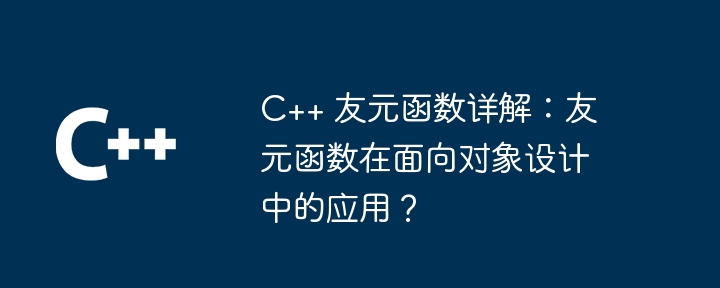Home >Backend Development >C++ >Detailed explanation of C++ friend functions: Application of friend functions in object-oriented design?
Detailed explanation of C++ friend functions: Application of friend functions in object-oriented design?
- PHPzOriginal
- 2024-04-29 15:12:01761browse
C A friend function is a special function that provides access to private and protected members of another class. Non-member functions can interact with a specific class by declaring friend functions. Applications of friend functions include operator overloading, I/O operations and underlying implementation. For example, friend functions can be used to overload operators to support operations between custom data types, as shown in the following case: class Vector { public: friend Vector operator (const Vector& v1, const Vector& v2); };

C Detailed explanation of friend functions: Application in object-oriented design
What is a friend function?
In C, a friend function is a special function that is granted access to private and protected members of another class. This allows non-member functions to interact with a specific class without having to be declared as a member function of the class.
How to declare a friend function?
There are two ways to declare friend functions:
- Declared in the class definition:
class MyClass {
friend void myFriendFunction();
};- Use
friendKeyword declaration:
class MyClass; // 前向声明
void myFriendFunction() {
MyClass obj;
// 访问 MyClass 的私有成员
}Application of friend function
Friend Functions have many applications in object-oriented design, including:
-
Operator overloading: Friend functions can overload operators, such as
*to support operations between custom data types. -
I/O operations: Friend functions can provide I/O functions for classes, such as
dc01603f162e8bccf508736ba29c0229>, to simplify object serialization. - Underlying implementation: Friend functions can access private members of the class to implement complex algorithms or internal data structures.
Practical Case: Operator Overloading
The following code example shows how to use friend functions to overload the operator to support Addition of two Vector objects:
class Vector {
int x, y;
public:
Vector(int _x, int _y) : x(_x), y(_y) {}
friend Vector operator+(const Vector& v1, const Vector& v2);
};
Vector operator+(const Vector& v1, const Vector& v2) {
return Vector(v1.x + v2.x, v1.y + v2.y);
}
int main() {
Vector v1(1, 2), v2(3, 4);
Vector v3 = v1 + v2; // 使用重载的 + 运算符
return 0;
}In the above example, the operator function is a friend function that allows non-member functions to access the Vector Private data members of the class x and y.
The above is the detailed content of Detailed explanation of C++ friend functions: Application of friend functions in object-oriented design?. For more information, please follow other related articles on the PHP Chinese website!
Related articles
See more- What is object-oriented JavaScript? Understanding objects in js
- What are the steps generally required to write a C++ program?
- How do C++ friend functions access private members?
- Detailed explanation of C++ friend functions: What is the difference between friend functions and global functions?
- Detailed explanation of C++ friend functions: How to restrict the access rights of friend functions?

